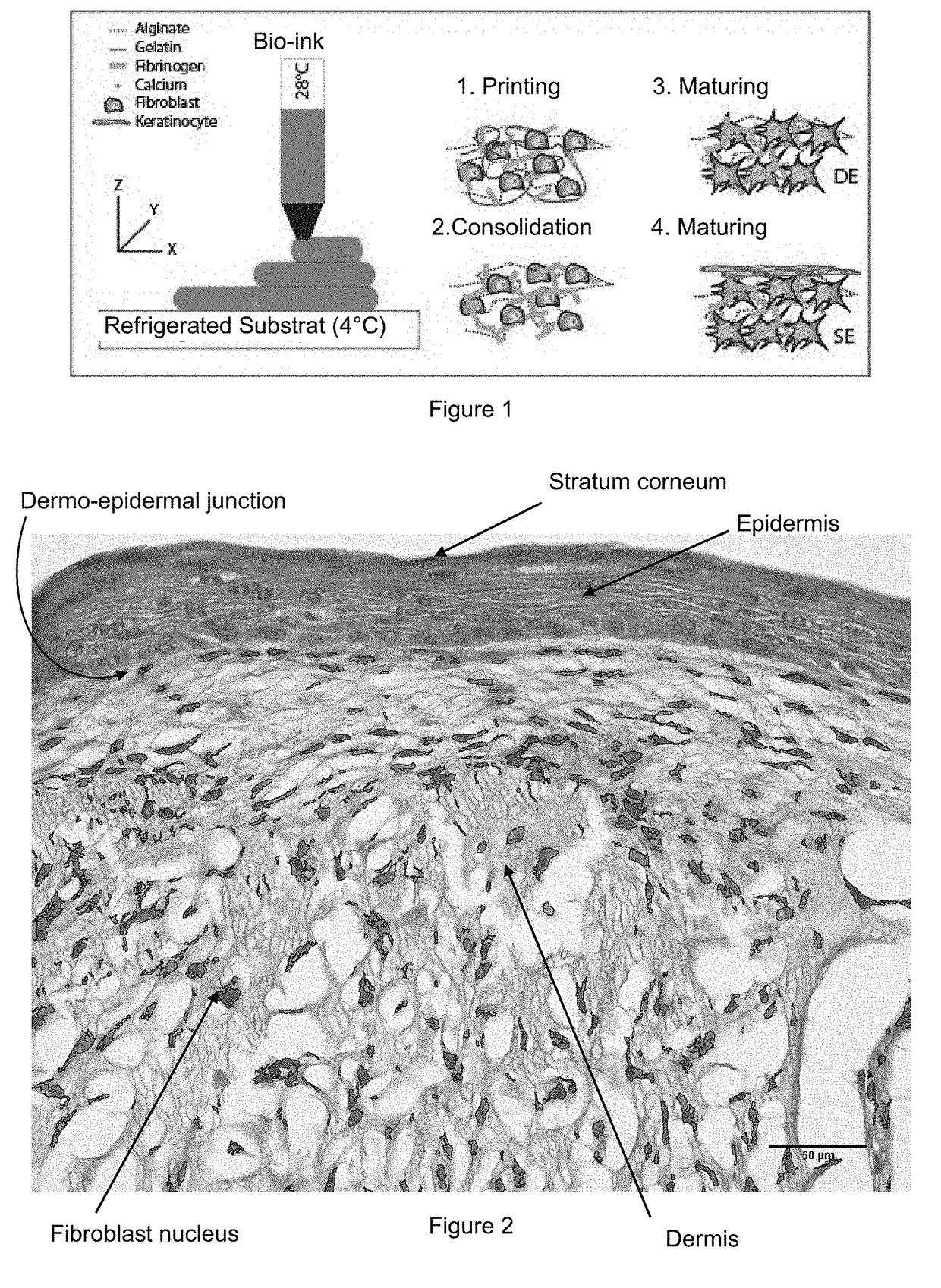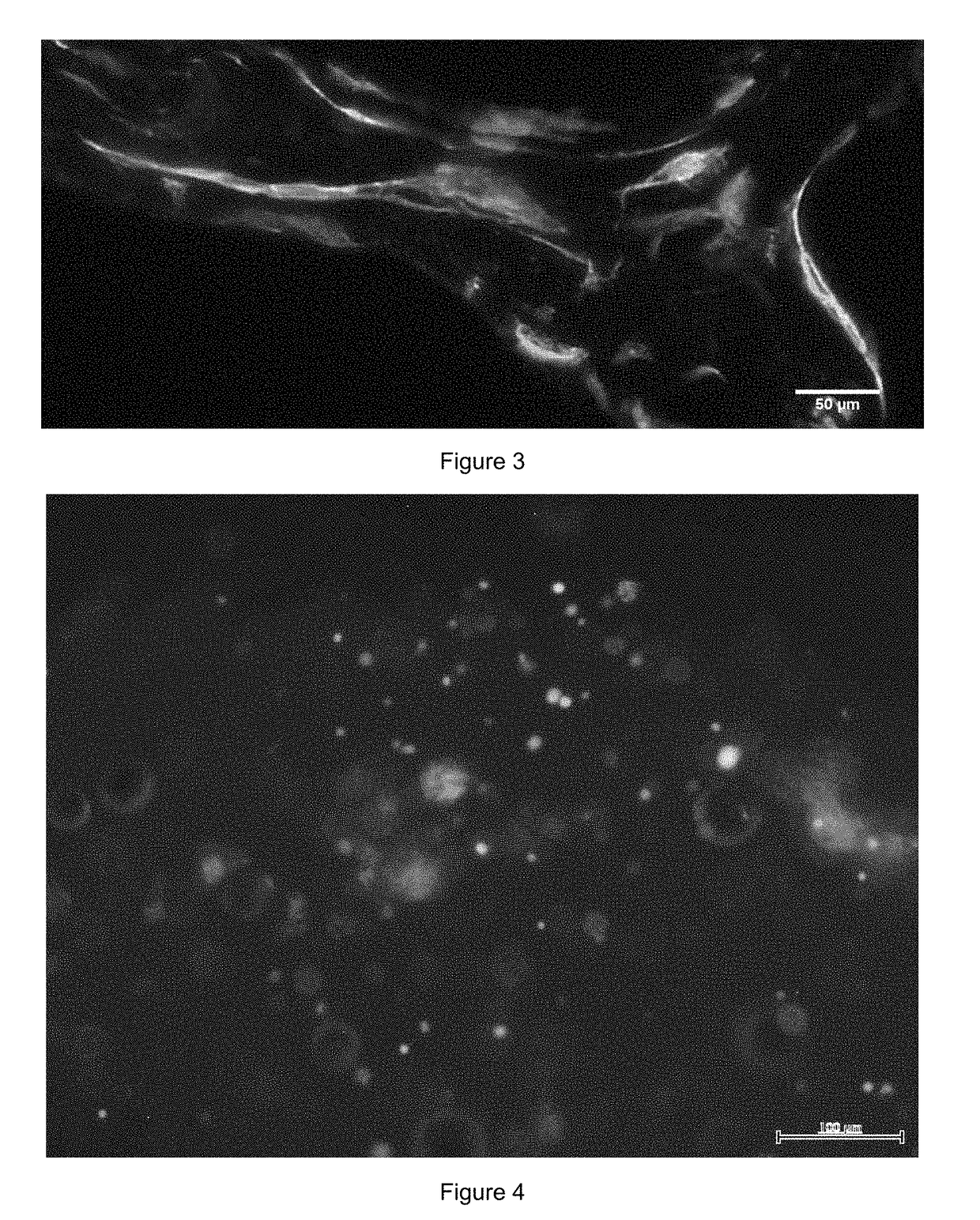Method for Manufacturing Body Substitutes by Additive Deposition
a technology of additive deposition and body, applied in the field of biotechnology, can solve the problems of toxicological problems, huge therapeutic stakes, and the risk of disturbing the product obtained
- Summary
- Abstract
- Description
- Claims
- Application Information
AI Technical Summary
Benefits of technology
Problems solved by technology
Method used
Image
Examples
example 1
nd Collection of Cells
[0115]This example illustrates a method for amplification and collection of cells (fibroblasts and keratinocytes) that can then be used in the fabrication of the skin substitute according to the invention.
[0116]Dermal keratinocytes and fibroblasts were isolated from a human preputium.
[0117]The keratinocytes were cultivated on human fibroblasts irradiated using a technique well known to a person skilled in the art, using the culture medium known as “Green's medium” containing DMEM and Ham's F12 (in the ratio 3:1), to which adenine was added (24.3 μg / mL) with the human epidermal growth factor (10 ng / mL), hydrocortisone (0.4 μg / mL), insulin (Humulin®, 5 μg / mL), 2×10−9 M tri-iodo-L-thyronine (5 μg / mL), 10−10 M isoproterenol, penicillin (100 U / mL), streptomycin (100 μg / mL) and 10% of fetal bovine serum. The keratinocytes collected during passes 2, 3 and 4 were used.
[0118]The fibroblasts were cultivated in an appropriate medium containing DMEM, 20% of new-born calf s...
example 2
n by Additive Technique (Method According to the Invention)
[0119]A first aqueous solution of gelatin was prepared by dissolving a gelatin powder at 20% m / v in a solution of NaCl at 0.9% m / v. A second aqueous solution of alginate was prepared by dissolving alginate powder (Very Low Viscosity) at 4% m / v in a solution of NaCl at 0.9% m / v. A third aqueous solution of fibrinogen was prepared at 8% m / v into which fibroblasts were added in suspension (obtained in example 1) at a cell concentration of 2 million cells / mL.
[0120]These three solutions were then mixed so as to obtain a mixture (called “bio-ink”) that contains 50 vol-% of the first solution (gelatin), 25 vol-% of the second solution (alginate) and 25 vol-% of the third solution (fibroblasts recovered in fibrinogen).
[0121]An aqueous polymerization solution was prepared containing 3% m / v calcium and thrombin at a final concentration of 20 U / mL.
[0122]Said bio-ink has a viscous transition at 29° C. It was heated to a temperature of a...
example 3
of the Skin Substitute Precursor (Method According to the Invention)
[0124]Skin substitute precursors were incubated for 12 days in a fibroblast culture medium containing 1 mM of ascorbic acid 2-phosphate; they were nourished every day. After twelve days, keratinocytes were applied on the surface of skin substitute precursors with a concentration of 2.5×105 cells per cm2.
[0125]Skin substitute precursors were incubated for a first seven-day incubation period immersed in Green's medium as described above, with a concentration of 1 mM of ascorbic acid 2-phosphate and antibiotics; they were nourished every day.
[0126]The skin substitute precursors were then incubated during a second 21-day incubation period, kept at the surface of the liquid in a differentiation medium containing DMEM with hydrocortisone (0.4 μg / mL), insulin (5 μg / mL), ascorbic acid 2-phosphate and antibiotics; the differentiation medium contained 8 mg / mL of bovine serum albumin.
[0127]Skin substitutes were thus obtained. ...
PUM
 Login to View More
Login to View More Abstract
Description
Claims
Application Information
 Login to View More
Login to View More - R&D
- Intellectual Property
- Life Sciences
- Materials
- Tech Scout
- Unparalleled Data Quality
- Higher Quality Content
- 60% Fewer Hallucinations
Browse by: Latest US Patents, China's latest patents, Technical Efficacy Thesaurus, Application Domain, Technology Topic, Popular Technical Reports.
© 2025 PatSnap. All rights reserved.Legal|Privacy policy|Modern Slavery Act Transparency Statement|Sitemap|About US| Contact US: help@patsnap.com



